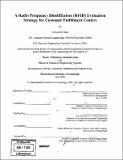A Radio Frequency Identification (RFID) evaluation strategy for customer fulfillment centers
Author(s)
Shen, Howard H. (Howard Hao)
DownloadFull printable version (7.647Mb)
Alternative title
RFID evaluation strategy for customer fulfillment centers
Other Contributors
Leaders for Manufacturing Program.
Advisor
Stephen C. Graves and David Simchi-Levi.
Terms of use
Metadata
Show full item recordAbstract
Radio Frequency Identification (RFID) is a wireless technology that can be used to track inventory labeled with microchip-embedded identifiers communicating passively with scanners without operator involvement. This non-line-of-sight technology has the potential of dramatically increasing the level of visibility throughout the supply chain for many types of products, assisting in defect reduction, increased granularity in inventory tracking, and decreased direct labor. In recent years, developments in RFID technology have decreased the cost of RFID equipment, and several large U.S. retailers have started to use RFID to track consumer products. However, what is not clear is whether or not these RFID implementations have yielded economic returns. Although RFID promises higher read rates and increased accuracy, how the technology works in particular warehouse settings is not clear. The first step to determining the feasibility of RFID in any organization is the complete evaluation of RFID technology. This document discusses an evaluation strategy using the Six Sigma DMADV framework. The strategy was carried out at internet retailer Amazon.com. (cont.) The document discusses the various steps required for a complete implementation of the evaluation strategy and refers to the evaluation at Amazon.com as a case study. The purpose of this document is to recommend a complete evaluation strategy of RFID system components for any customer fulfillment center that is thinking of implementing this technology to replace existing tracking technologies such as bar code or other manual forms of tracking.
Description
Thesis (M.B.A.)--Massachusetts Institute of Technology, Sloan School of Management; and, (S.M.)--Massachusetts Institute of Technology, Engineering Systems Division; in conjunction with the Leaders for Manufacturing Program at MIT, 2006. Includes bibliographical references (leaves 66-67).
Date issued
2006Department
Leaders for Manufacturing Program at MIT; Massachusetts Institute of Technology. Engineering Systems Division; Sloan School of ManagementPublisher
Massachusetts Institute of Technology
Keywords
Sloan School of Management., Engineering Systems Division., Leaders for Manufacturing Program.